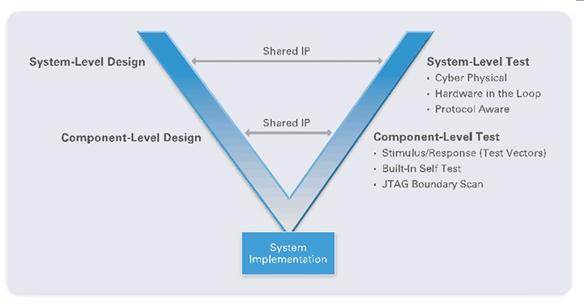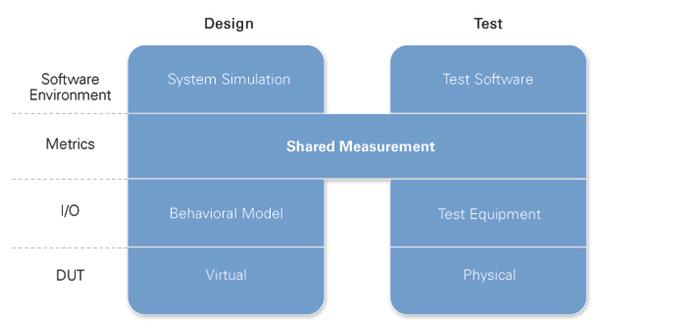 Eric Starkloff, Vice-President of Product Marketing for Systems Platforms at National Instruments, leads the product marketing of the company’s system-level products, including PXI, modular instruments, and NI CompactRIO. Since joining NI in 1997 as an applications engineer, he has held several leadership positions including NI TestStand product marketing manager, software group manager, PXI product strategy manager, and director of product marketing for modular instruments, PXI, and instrument control. Under his leadership, the PXI platform has become a major growth driver for NI and one of the most successful test platforms in the history of the test industry.
Eric Starkloff, Vice-President of Product Marketing for Systems Platforms at National Instruments, leads the product marketing of the company’s system-level products, including PXI, modular instruments, and NI CompactRIO. Since joining NI in 1997 as an applications engineer, he has held several leadership positions including NI TestStand product marketing manager, software group manager, PXI product strategy manager, and director of product marketing for modular instruments, PXI, and instrument control. Under his leadership, the PXI platform has become a major growth driver for NI and one of the most successful test platforms in the history of the test industry.
MWJ: What sets National Instruments (NI) apart from other test and measurement vendors?
Starkloff: NI believes that the future of test and measurement is in using user-defined software to add flexibility to modular hardware systems. Our vision for graphical system design is to create a highly productive software and hardware platform that allows engineers to quickly design many different types of systems. For example, they can build high-performance, application-specific test systems and upgrade them as needed when new requirements emerge.
Software has become the most important technology in the T&M industry due to the rapid increase in the performance of off-the shelf ADC, DAC and RF front-end technology. Twenty years ago, T&M vendors were able to differentiate themselves by developing innovative, high-performance components and converters. Today, however, some of the best analog technology is accessible to vendors through off-the-shelf products. As a result, software – and not hardware technology alone– will be the defining characteristic of test equipment in the coming years.
MWJ: What’s the story behind the AWR and Phase Matrix (PMI) acquisitions?
Starkloff: For over a decade, National Instruments has been investing heavily into products, technologies and resources for the RF and microwave industry. As an example, our latest RF signal analyzer, the NI PXIe-5665 VSA, has won numerous awards for its industry-leading performance and is a testament to the investment National Instruments is making to build the best RF instruments in the industry.
The acquisitions of AWR and Phase Matrix add key software and hardware technologies to the NI platform. AWR is the technology leader in high frequency EDA. AWR’s products and people are incredible assets to NI and our mutual customers. The combination of AWR design software and the NI prototyping and measurement platform will be a powerful tool for customers designing, prototyping, and testing RF and microwave devices. As an example, the current version of AWR’s Visual System Simulator™ (VSS) software environment now features native connectivity to NI LabVIEW software and PXI hardware.
Phase Matrix has industry-leading technology for high frequency hardware components and systems; engineers at Phase Matrix have designed some of the highest frequency front ends on the market today. This capability will allow us to expand the performance and frequency coverage of our measurement platform.
MWJ: Why is NI uniquely positioned to help engineers better utilize instrumentation earlier in the design flow?
Starkloff: The flexibility of National Instruments hardware and software – including environments such as LabVIEW and AWR design software – is key to enabling engineers to better leverage instrumentation within design.
The concept of combining simulation software and measurement hardware in the RF and microwave product design flow has long been a highly desired, yet elusive, concept. In theory, the idea of merging the design and test processes should provide clear benefit such as shorter time-to-market. However, in practice, the enabling technologies that effortlessly allow engineers to use a common toolset from initial design through production test are just emerging.
For years, the “V” diagram has been used to illustrate the integration of design and test in industries with highly complex products – especially in automotive and aerospace/defense applications. In these industries, where the end product is a highly complex “system of systems,” the left side of the V-diagram (shown in Figure 1) is considered “design,” and the right side represents “test.”

Figure 1. The V-Diagram illustrates the practice of integrating design and test processes
The idea behind the V-diagram is that greater efficiency can be achieved by beginning the test and validation of subsystems before development of the entire system is complete. For example, you can start with a system level description of an RF device and create software measurement components while the design is still purely in simulation. Later in the design process, when some of the components are actually prototyped, you can reuse these software-based measurements on actual measurement hardware and also use hardware-in-the-loop techniques to marry the real world signals to the simulated components. While the use of concurrent design and test approaches such as the V-diagram is common in industries with highly complex systems, the practice of integrating design and test processes is becoming increasingly popular in other industries such as microwave & RF. Working together with AWR, we will create the right product integration points to make this a reality.
MWJ: What does NI try to do to make customers more productive?
Starkloff: National Instruments has a long-standing focus on making engineers more productive, often through providing a level of abstraction that enables them to accomplish their job while properly handling some of the details needed to actually make the system work. One such area where we are focused is with our LabVIEW FPGA software. In the past, being able to connect a programmable FPGA to an RF front end required detailed expertise in VHDL programming practices. Today, however, our customers can use the intuitive graphical language of LabVIEW, G, to program their RF instruments – targeting real-time signal processing algorithms on the instrumentation. This abstraction results in great gains in productivity but also in performance since algorithms embedded in an FPGA can often run many times faster than those running on a processor.
MWJ: What HW products will we expect from the PMI acquisition?
Starkloff: It’s well known in the industry that Phase Matrix has the technology to build not only some of the highest-frequency RF front ends in the industry but also fast-tuning and low phase-noise oscillators that are second to none. Now working together as a National Instruments Company, we’ll accelerate the development of RF instrumentation and roll out these technologies within a broader product portfolio, primarily within the industry-standard PXI platform. We already offer a 26.5 GHz PXI vector signal analyzer, for example, based on Phase Matrix technology.
MWJ: What products will we expect from AWR & LabVIEW integration
Starkloff: The goal is to create the right integration between design and real-world I/O to accelerate the design process. A real-world measurement system contains several similarities with how a “virtual” product is measured in the EDA world - as shown in Figure 2. For example, just as the EDA software measures and reports the virtual output of the DUT, instrumentation is used to capture similar data in the physical world. Thus, an immediate opportunity to improve the efficiency of the development process is to reuse measurement algorithms (communication standards and/or specific SP waveforms) from test equipment earlier in the design flow process. This has the additional benefit of delivering better correlation between measurements from design through test.

Figure 2. Comparison of the EDA vs. Test Bench Architecture
Starkloff: Historically, the idea of reusing a measurement algorithm from test equipment in the design process was virtually impossible: the first instruments designed to test wireless equipment were completely self-contained boxes, and lacked the flexibility to do anything but behave like an instrument.
In contrast to fixed-functionality instruments, the NI platform is based on software-defined instruments that leverage multicore processors and FPGAs. At the same time, today’s EDA software environments are capable of increasing connectivity to system design software such as LabVIEW. For example, a new feature in AWR’s Visual System Simulator (VSS) software is a node on the diagram that enables the user to exchange data with NI LabVIEW diagram. The VSS to LabVIEW connectivity is a prime example of how the lines between EDA and test bench software environments are being blurred and how this can then provide a straightforward path to gaining greater engineering efficiency. Over time, you will see more examples of integration that improves the ability to move between simulation and real-world I/O for rapid prototyping and integration of measurements into the design flow.
MWJ: What is the biggest trend to watch out for in the T&M industry
Starkloff: A significant trend that we continue to see is with the growing role of software in what was once considered to be a highly hardware-centric industry. NI and AWR are already working on ways to improve engineering design productivity through software and a more meaningful integration of measurements into design tools. Longer term, the way engineers use software will continue to evolve as we are already witnessing how software enables engineers to use instrumentation not only to measure signals – but also to emulate and model how a real-world product behaves.
National Instruments is committed to creating a unified design and prototyping platform that embraces design and simulation software and I/O hardware based on multicore processors and FGPAs. I believe this approach will redefine the way engineers design and test products and keep them competitive in designing next generation RF and microwave products that lead to new products and systems.
